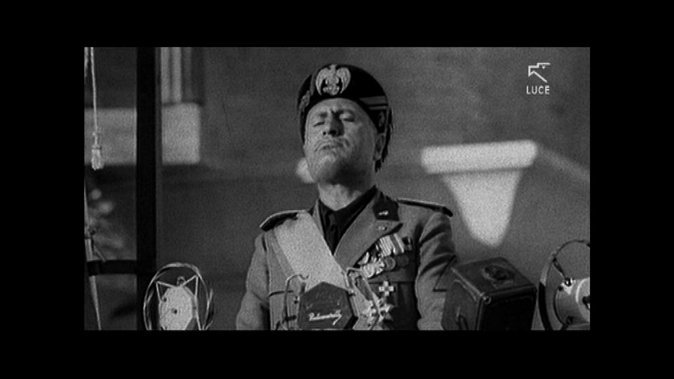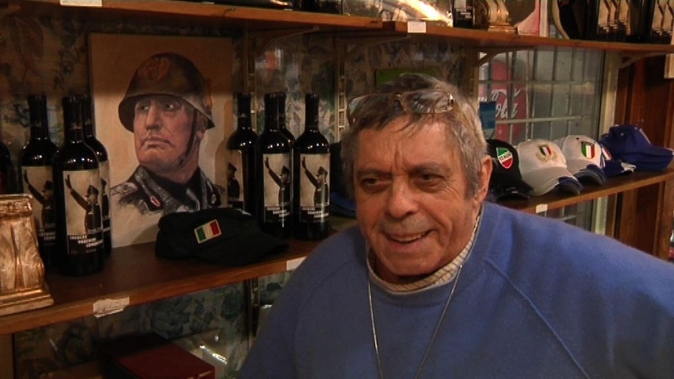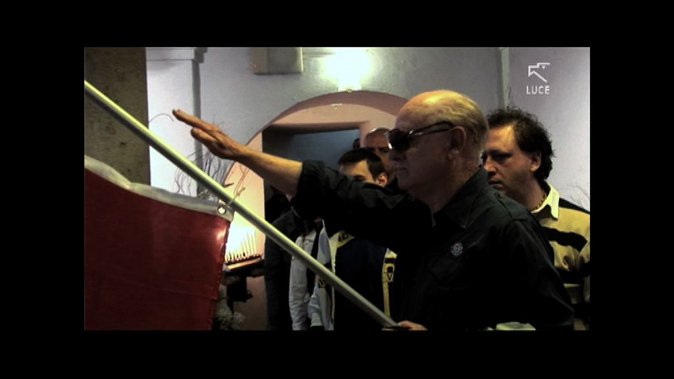
Last week I did a story for AP Television on a fascinating new documentary film called “Il Corpo Del Duce”, “The Duce’s Corpse.” AP wire put out the story and I am amazed to see how widely it was picked up in the US. I am attaching some links below in case anyone wants to read the story.
The Seattle Post Intelligencer
Just a quick summary. The film follows Mussolini’s body from when he was shot dead in northern Italy by partisans as he was trying to escape into Switzerland. His body was hanged, together with his lover’s body, upside down from the top of a gas station in a piazza in Milan. The film follows the various misadventures of the corpse– buried, dug up, packed into a soap crate– until it was given back to his wife in 1957 and put in a tomb in Mussolini’s hometown in Northern Italy. Some 50,000 people still visit the tomb every year, according to the film. One of the first stories I covered when I began working for AP Television was filming Mussolini’s granddaughter, Alessandra Mussolini, a member of the Italian parliament, bringing her newborn daughter to pay homage at her grandfather’s tomb in 1995. For my TV story last week I interviewed a man named Pasquale Moretti at a bar he owns in Rome that is filled with all sorts of Mussolini paraphernalia. Moretti told me that he thinks Mussolini is up there with the greats of history, right alongside Julius Ceasar.

(Since I am interested in questions about women in Italy, I find it telling that Mussolini was shot together with his lover Clara Petacci, but his body was eventually given to Rachele, his loyal wife, and mother of his five children, in 1957. Not sure which one got the better deal.)
What makes the film interesting is the way the director, Fabrizio Laurenti, has knit together images of a powerful, vital Mussolini in life with shocking pictures of his disfigured, mummified corpse in death. The film studies the Italian attitudes towards death (more on death and funerals in Italy in another post) and the human corpse and ties it into the Catholic culture. Catholics do not believe in cremation and have a tradition of perserving corpses or pieces of them. I have learned a lot about this while covering the Vatican for years, including covering the death and funeral of John Paul II and all the ceremony that surrounded that event. For example, one can often find relics (fingers, ribs and vials of blood) of saints in Italian churches. I tend to get a bit squeamish, but for Italians it is absolutely normal.
The film also prompts questions about how cults develop around leaders. How did Mussolini become a cult figure to so many Italians? Is a myth created through government propaganda alone? There are many similar examples of leaders who have become larger-than-life in their countries: Ataturk, Mao, Evita Peron or Che Guevara to name a few…

My AP story was picked up by many websites in the US, among them the Huffington Post

Wow- simply amazing. I hope I can see the film here in the U.S. I did not know the half of Il Duce’s end. Thanks for the enlightenment. It is surprising how cults form around deceased leaders. It seems to happen everywhere, just with varying degrees of intensity and outpouring. Some of our leaders are greater in death than life, missteps and crimes forgotten, overlooked or whitewashed.. But right up there with Julius Caesar… oh my. Thanks for an altogether fascinating post.
. . read a fascinating book many years ago about SS-Obersturmbannfuhrer (Lt Col) Otto ‘Scarface’ Skorzeny of the Waffen SS, who lived out his life after the war as a scrap metal dealer in Spain and died back in 1975. Skorzeny was a ruthless, amoral soldier with an audacity and courage unmatched by others of his trade. He it was who rescued Mussolini from his original captivity in the Alps by crash-landing gliders onto the chalet where he was held.He was contemptuous of the man and made no secret of it. No doubt he smiled when he learned of Benito’s fate.
Skorzeny became notorious leading from the front in the Battle of the Bulge for the infiltration techniques of his troops when they dressed as nuns and took no prisoners.
Alan, that is fascinating. If you can remember the name of that book, pass it along, I would love to read more about Skorzeny. I will google him now.
I was also hoping I could get you to comment on what seemed to me to be a bit of an Ataturk cult the few times I visited Turkey. Where is Ataturk buried? Do people visit the place?
Brava Trisha – what an interesting story! I am finding myself envying your job, with exposure to so many opportunities to explore such a wide variety of interesting topics. You had me rolling on whether the mistress or the wife had rec’d the better deal. How does a Mozzarella Mamma talk to her kids about this era of Italian history? Or the fingers of saints, for that matter?
It is a fascinating story. Nico – my 16-year-old – was pretty blown away when I came home after my interview with Mussolini fan Pasquale Moretti and plopped down 10 matchboxes with photos of Mussolini on them. Nico already has strong ideas about communism and fascism. In Italy one grows up with it all around you. There is fascist architecture all over Rome, and there are still political parties that have descended from Italian communist and fascist parties. As far as the women are concerned, I have not gotten into that yet with my kids, but I will.
I asked Alan and I will ask you as well– is the Ataturk cult similar in Turkey? What happened to him after he died, where is he buried? Do people visit the place?
The American in me is shocked and amazed at this continued reverence to il Duce…however the Turkish-American influence in me is not surprised given the reverence paid to Mustafa Kemal Ataturk in Turkey. The extreme “Kemalism” does not, as far as I can tell, extend to the corpse following film…but similar. Of course, this is similar to leader worship (required or otherwise) around the world – I am thinking of things I have seen on my own travels – Kennedy’s picture in people’s houses around the U.S., photos of Soviet leaders everywhere during a 1983 visit to the former USSR and of course Ataturk’s photos just about everywhere, God-like, in Turkey. I feel a post coming on about this topic.
I would love to read a post by you on this topic. When I visited Moscow last year, I enjoyed seeing an enormous portrait of Lenin in the subway station, I felt like I had stepped back in history. Nico has a huge Che Guevara poster up on the wall of his room. JFK is another who has become larger than life. So, I am guessing in the case of dictators — Mussolini, Stalin — it is propaganda that creates the cult. But with the others I am not sure. Also I am wondering if it is more likely to happen to men than women. The only women I could think of was Evita Peron and maybe Cleopatra. So I would be very curious to hear your thoughts and M’s perspective too.
My mother spent most of her youth in Italy from 1920-1945, She worked as a singer for US armed forces live radio in Rome during the German occupation. She had little respect, much less admiration, for il duce. She considered him a clown and puppet of Hitler, who used him & was much smarter. Not that she admired Hitler, she just thought Mussolini was a dumb peasant with illusions of grandeur, who thought he would become great alongside his BF Adolf.
Barbara– What a fascinating story. I would love to learn more about your mother. How did she end up in Italy, and how did she get to the States? She must have had some amazing stories to tell. Please share a few more details. One of my favorite books about Italy is “Naples ’44” written by Norman Lewis, a British Intelligence Officer who was based in Naples after the allied invasion. Those were cetainly interesting times.
Wow, did Huffington Post really reprint this post? Big time….That’s cool.
My first reaction was how can people revere the memory of an authoritarian head of state who only got his country into trouble? Yes, he made the trains run on time but what else? Then I thought about all the people in the US with confederate flag decals on their cars or how the public eats up untrue simplifications mouthed by our would be nominees for their party nomination for President.
We do live in interesting times.
The Huffington Post– and all those newspapers listed– printed my AP version of the story. Click on the word “Huffington Post” in my blog post and you can read the whole story. We do live in interesting times. I am lucky not to have lived in Mussolini’s times, but we’ve all seen a lot of history being made in the last 25 years between the Berlin Wall going down, September 11th etc. I often feel in my job that I am witness to history, even just small pieces of it.